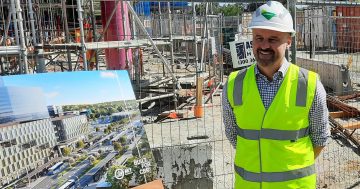
Chief Minister Andrew Barr said the budget position looks promising despite COVID-19 struggles. Photo: Lottie Twyford.
The post-pandemic economic recovery is underway, according to the Chief Minister, who has announced an improved budget deficit position for the December quarter.
The December quarter headline net operating balance was a deficit of $218.8 million compared with a forecast year-to-date budget deficit of $464.3 million.
These improvements to the Territory’s fiscal position gave Chief Minister Andrew Barr cause to be “cautiously optimistic about the year ahead”.
Mr Barr told the Assembly that total revenues were at least $230 million better than forecast.
An additional $134 million in GST revenue was also recorded, compared to what was projected, and the Territory’s taxation revenue improved by $86.2 million.
The Chief Minister attributed the latter to an improving labour market and increased commercial property market activity which he said reflected strong business confidence about investing in the Territory.
Mr Barr also referred to “recent strong retail trade figures and strong credit card spending data, as well as an increase in the household savings rate” as positive signs the economic recovery has begun.
As foreshadowed by Mr Barr’s opening address to the Legislative Assembly on Tuesday, the government will continue to provide targeted economic support to specific sectors when and where it is needed.
Mr Barr told the Assembly his government is unafraid to invest “public finances to avoid the harsh realities recessionary environments can have on the economic prospects of young people and women”.
Job creation in a diverse range of sectors and industries will remain a priority of the ACT Government.
“It is the role of every government in Australia to create the environments to drive up aggregate demand. It requires us to be bold and to take on more risk,” Mr Barr said.
Mr Barr also hit out at the Opposition whose economic policies he accused of “flipping between regurgitating their reflex conservative political lines against public spending and debt on some days whilst calling for more government intervention and assistance on others”.
Earlier this week, the Opposition spokesperson for business Leanne Castley put forward a motion calling for an updated economic plan.
Ms Castley said many small businesses weren’t going to survive unless things got back to normal soon and people went out and bought their coffees, lunches and meals at local cafes, pubs and clubs as they had before the pandemic.
However, she wouldn’t say it was time for public servants to return to the office just yet.
“Businesses just want to get back to business,” Ms Castley said.
Ms Castley referenced a recent CommSec State of the States report and the ABS Labour Force report to claim the ACT’s economy was on the downturn, although Minister for Business Tara Cheyne accused her and her fellow Canberra Liberals of simply cherry-picking data to suit their narrative.
“I will leave it to those opposite to continue talking down the ACT’s economy,” Mr Barr said.
“We remain optimistic about the direction of economic activity this year.”
When the 2021-22 ACT Budget was delivered in October last year, a deficit of $951 million was forecast.
Mr Barr warned at the time that while the budget deficit was necessary, there wasn’t a bottomless pit of money, and some major projects such as the stadium and convention centre would need to be pushed back so the budget could eventually be brought under control.





















